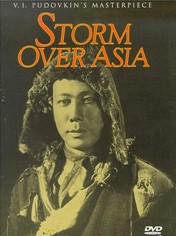When: Saturday morning
Director: Vsevelod Pudovkin
Duration: 128 minutes
Presented by: Dr Karen Pearlman from the Australian Film, Television and Radio School
This digital presentation is the original full-length Soviet version, fully titled in English, with a new score composed and conducted by Timothy Brock and performed by the Olympia Chamber Orchestra.
In 1918 a simple Mongol herdsman escapes to the hills after brawling with a western capitalist fur trader who cheats him. In 1920 he helps the partisans fight for the Soviets against the occupying army. However he is captured when the army tries to requisition cattle from the herdsmen at the same time as the commandant meets with the reincarnated Grand Lama. After being shot, the army discovers an amulet that suggests he was a direct descendant of Genghis Khan. They find him still alive, so the army restores his health and plans to use him as the head of a Mongolian puppet regime.
The Heir of Gehghis Khan/Potomok Chingis-Khan] (Mezhrabpom-Russ Production; Directed by Vsevolod I. Pudovkin; Photographed by Anatoli Golovnia; Scenario by Osip Brik from a story by I. Novokshonov. Cast: Valeri Inkizhinov, A. Christiakov, A. Dedintsev. Music composed and conducted by Timothy Brock. Storm Over Asia is a revolutionary melodrama, described by critics as an “epic poem” and “one of the most perfect examples of the formal beauty of a silent film.” V. I. Pudovkin, whose Mother (1926) and The End of St. Petersburg (1927) placed him with Eisenstein, Vertov and Dovzhenko in the forefront of Soviet filmmakers, directed this production in 1928 in remote Mongolia, incidentally providing the first film documentation of traditional life there.
The hero is portrayed by Valeri Inkizhinov, a Mongol who had been Pudovkin's fellow student at the State Film School and who guided the company to its exotic locations; his father in the film is played by his actual father, filmed where he had always lived.
The plot, although as engaging in its sensational energy as any Hollywood production of the high silent era, can barely explain the film's emotional power. Pudovkin's expressive imagery, visual metaphors, brilliant editorial organization and Golovnia's shimmering photography make up the difference. This is the original version, about a half hour longer than the one previously distributed in the United States.

